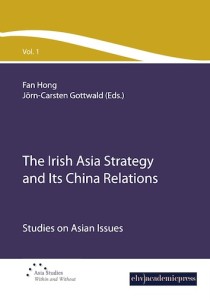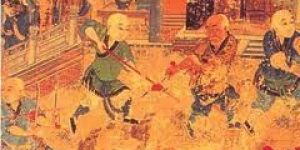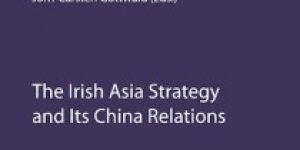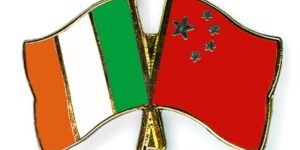Chapter 7: Sino-Irish Relations – The View From China ~ The Irish Asia Strategy And Its China Relations
No comments yet “Formerly we thought than the foundation of our wealth would be established if only western methods were stressed, and that the result would be achieved immediately…unfortunately, we are merely copying the superficialities of the western methods, getting only the name but very little substance…superficial imitation is not so good as arousing intellectual curiosity. The forges and hammers of factories cannot be compared with the apparatus of people’s minds.”
“Formerly we thought than the foundation of our wealth would be established if only western methods were stressed, and that the result would be achieved immediately…unfortunately, we are merely copying the superficialities of the western methods, getting only the name but very little substance…superficial imitation is not so good as arousing intellectual curiosity. The forges and hammers of factories cannot be compared with the apparatus of people’s minds.”
Wang T’ao 1870[i]
For much of the past thirty years both China and Ireland have been involved in radical reform programmes that have placed their respective governments to the fore. In taking the strategic decision to open their economies to the outside world, learning, experimenting with and harnessing new ideas and technologies to the service of their societies each can be said to have achieved an astounding level of success. Neither has allowed themselves the comfort of introversion, working with particular effectiveness since the end of the Cold War to move from the periphery to the centre of the international system. In doing so both countries have found greater opportunities to express and develop their own voice, discovering significant common ground along the way. Both are united in their commitment to a more balanced and effective international system, the maintenance of a peaceful international environment in which countries committed to economic development can seek, find and take advantage of opportunities.
While these distant neighbours find themselves on the opposite extremities of the Eurasian continent it is the similarities between them that draw them together. Both call upon a considerable heritage of cultural and technological innovation in the crafting of their self image. If their political philosophies and social systems have developed along very different tracks then this should not diminish a profound respect for each others successes – few other countries can claim to have so successfully turned the forces of globalisation to the service of their societies.
What follows in this chapter is an insight into the way that China views Ireland. The chapter unfolds first by summarising the general perception of Ireland that exists in China today. Subsequent sections explore the different strands that have contributed to this perception setting these against larger trends in China’s transformation. The final section suggests that for Sino-Irish trends to continue their positive arc much will have to be done to orchestrate an increasingly disparate and potentially fractious set of relations.
7.1 Ireland: A View from Afar
Perhaps unsurprisingly Ireland has not captured the imagination of the average Chinese citizen, most of whom have enjoyed only sporadic and limited encounters with things Irish. There is for example little awareness of the distinctive role Irish individuals have played in the shaping of Chinese relations with the rest of the world, whether through the intercession of Lord McCartney, first envoy of Britain to China or the intervention of Sir Robert Hart in establishing the Imperial maritime custom service which helped prolong the twilight of Qing dynasty. Aierlan, where it exists at all dwells in the collective imagination as a jumble of images and pubic figures spanning the breathtaking beauty of the Cliffs of Moher to Roy Keane, Riverdance and a host of Nobel Prize winners.
Among China’s elite the conception of Ireland is more complex if still partial. The young tiger’s colonial past, its consequent struggle for recognition, and determination to lift itself out of poverty strike a chord with Chinese experience. Beyond these impressions Ireland’s desire to pursue a neutral path in world affairs based on the international rule of law, one respectful of the one-China principle resonates strongly with a Chinese worldview that places multi-polarity and cooperative, consultative approaches to problem solving to the fore. If there are nuances and occasional contradictions to this policy they neither detract nor deviate from Beijing’s fundamental commitment to the creation and maintenance of a stable international environment, built upon the five principles of peaceful coexistence: mutual respect for sovereignty and territorial integrity, mutual non-aggression, non-interference in each other’s internal affairs, equality and mutual benefit, and finally peaceful coexistence sensitive to the needs of developing countries.
Such perceptions are both relatively new and tentative, being formed in the flurry of activity that began towards the end of the 1990s. It is during this period, the height of the Celtic tiger phenomenon that frequent Chinese trips, often with sponsorship from Irish state agencies such as Enterprise Ireland began to generate awareness bringing clarity and substance to what would have otherwise been a relationship of mutual indifference.
7.2 The Political Relationship
Reading too much into these perceptions might lend an unrealistically positive spin on the importance of Sino-Irish relations one that belies the reality that Ireland finds itself as just one of many, many suitors driven to China by competitive pressures, a quest for position before market share has been fully divvied out. Comparatively speaking, attention, at least from the top most levels of government has been sporadic at best with the tempo and status of contact dictated largely by Ireland’s relative position within the international system, both in terms of the EU (particularly the presidency) and UN. As such wherever Ireland’s profile within these institutions is raised the negotiating power of the Irish government becomes invested with more significant weight. With the exception of EU related issues that require anonymity, such as the lifting of the arms embargo or market economy status (both staples of discussions) the lack of political tensions between the countries has meant that Ireland is seen in both bilateral and multilateral terms, the latter reflected in its position within the western European desk of the
foreign ministry.
If politically speaking Ireland’s relative importance to China is not great this should not be taken to mean that Ireland is unimportant to China. Since diplomatic relations were formally established in 1979 Sino-Irish engagement has progressively expanded to cover a broad range of issues and interests outside of the political arena. The political capital which create room and bless these strands come from a number of avenues such that whether on the edges of the UN, as part of the European Union, or bilaterally there is considerable choice in terms of the channels of interaction with Ireland. Specific to the latter avenue the China-Ireland joint commission on economic, institutional, scientific and technological cooperation provides a specific steering mechanism, often acting as a clearing house for issues to compliment normal embassy and ministerial lines of communication. Momentum has been ensured through the steady flow of diplomatic traffic between Beijing and Dublin, with visits from the Chinese side such as those Minister of Health Cui Yueli in May 1983, Minister of Culture Zhu Muzhi in May 1985, Minister of Agriculture He Kang in July 1985, Minister of Foreign Trade and Economic Cooperation Zheng Tuobin in May 1986, State Councillor and Minister of Foreign Affairs Wu Xueqian in May 1986, Vice Minister of Foreign Affairs Zhou Nan in September 1988, Minister of Civil Affairs Doji Cering in October 1994, Minister of Foreign Trade and Economic Cooperation Wu Yi in April 1995, Vice Premier and Minister of Foreign Affairs Qian Qichen in October 1995, Vice Chairman of the National People’s Congress Standing Committee Tian Jiyun in March 1996 and Vice Premier Li Lanqing in April 2000, Vice Chairman of the Chinese People’s Political Consultative Conference Song Jian in May 2001, Premier Zhu Rongji in September 2001, Vice Chairwoman of the Foreign Affairs Committee of the Standing Committee of NPC Li Shuzheng in September 2001,Vice Chairwoman of the Standing Committee of NPC and Chairwoman of All-China Federation of Women Peng Peiyun in October 2001, Vice Chairman of the Chinese People’s Political Consultative Conference Ye Xuanping in October 2002 and Premier Wen Jiabao in 2004. Beyond these more high profile visits a range of contacts have developed to reflect a growing interest in the success of the Celtic tiger.
The results of these contacts have been a number of notable agreements, of particular relevance to the trends explored within this chapter are the agreements on Cultural Cooperation signed in May 1985 which marked the first concrete cooperation between the two, an Agreement on Scientific and Technological Cooperation (September 2000); an Ireland-China Research Collaboration Fund Agreement (December 2002); a Memorandum of Understanding on Cooperation in Software Sector between the Ministry of Commerce of China and the Department of Enterprise, Trade and Employment of Ireland (January 2005); and an Agreement on Cooperation between China National Committee of Natural Sciences Foundation and Science Foundation of Ireland (January 2005). Many of these have followed on from an initial Agreement on Economic, Industrial, Scientific and Technological cooperation (May 1986).
7.3 The Key Players on the Chinese Side
Before proceeding to explore the what of Sino-Irish engagement it is important at this juncture to understand the how of China’s foreign policy. At the theoretical apex of this policy making machinery stands the State Council which has traditionally been charged with dealing with the day to day direction of policy as well as the establishment of international agreements. Save where more elaborate policy departures necessitate the blessing of the party it is this institution and the different and shifting alliances within it that are primarily responsible for China’s foreign relations. Beyond the Council the Ministry of Foreign Affairs has continued in its traditional role conducting day-to-day relations with China’s partners. Innovation comes through experience and the growing influence of China’s economic and foreign policy think tanks, such as the China Centre for International Strategic Studies, Centre for Contemporary International Relations, China Academy of Social Sciences and State Council Development Research Institute, the China Institute of International Studies (CIIS)and Shanghai Institute for International Studies which together with the various in-house research units of China’s ministries (particularly MOFCOM and the ministry of Finance) provide much needed advice and projections. While these think tanks respond to requests from the State Council for research, analysis and proposals they have to a limited extent helped define the policy agenda, acting as occasional policy entrepreneurs that are now furiously courted by academic and governmental authorities from around the world.
The hierarchy of this institutional framework has become blurred further with the advent of international integration, Engagement has exerted a profound influence on China’s pattern of governance such that functional, line ministries normally not associated with external relations (for example the ministries of Finance or Agriculture) have seen their portfolios assume more international dimensions. This latter trend has necessitated the establishment of internationally active bureaus and departments, each tasked with the management of such disparate tasks as technical exchange and policy coordination to service the more bland and complex demands of reform.
In terms of Sino-Irish relations these trends have placed the Ministries of Commerce (and its predecessor the Ministry of Foreign Economic Relations and Trade), Finance, Industry and the China Council for the Promotion of International Trade among the ranks of key state players, with MOFCOM playing the principle gatekeeping role in terms of cooperation and exchange. A focus on national level institutions provides only a partial account, further complicating matters has been the empowerment of local and regional authorities who in exploiting the avenues created by past Chinese leaders focused on promoting growth have established their own international presence. Inevitably the involvement of, so many actors has had a dramatic impact on the development and proliferation of horizontal linkages, whether commercial, political, academic or cultural in nature. While most of these links are unlikely to have an immediate or dramatic effect on overall policy they have given relations a more practical, flexible vehicle to ensure there are always some win-win scenarios at play.
7.4 The Knowledge Pillar
Taking a narrow political focus would reduce Sino-Irish relations to a minor footnote but by adopting a broader perspective, one that takes into account the shift to a more pragmatic, bureaucratic brand of foreign policy that allows for the various interests of China’s line ministries to come to the fore, a very different story is revealed. At its most essential the relationship is focused on the development of knowledge capital such that Ireland’s development model, regarded as successful, and innovative is of great interest. To understand the why of this it is important to explore the context of China’s reform process – its governance restructuring.
As is widely acknowledged the difficulties brought about by the Great Leap Forward and Cultural Revolution, coupled with decades of autarkic policies reduced China’s economy to the point of bankruptcy. Lacking either the resources or know how to modernise on its own China took the prudent step of turning outwards and opening up to the world once more. Rather than seeking to reinvent the wheel the Chinese government has looked abroad for examples to follow, thus, beginning in 1978, Chinese elites began to actively solicit technical assistance and aid, raising the tempo of their courtship of foreign actors in search of capital, managerial expertise and technologies. In so doing China signalled a renewed willingness to engage with Western ideas, a willingness that reshaped its relationship with the outside world from one of exclusion and opposition, to integration and participation. The ensuing series of reform programmes, did not mean wholesale westernisation but rather involved an elaborate series of “(semi) contained” experiments, whose purpose has been to divine an appropriate blend of Chinese and Western ideas and institutions with which to lead China back to prosperity. In seeking to make China’s economy more market orientated the Chinese government also accepted that development strategies would have to be adopted to encourage private investment both domestic and foreign. Achieving such an objective, while dealing with the contradictions and consequences of previous development they realised would be impossible without overhauling and, perhaps, completely rebuilding the country’s legal and institutional framework to create a climate of stability and predictability more suitable to investors. Broader governance and regulatory reforms intended to progress incrementally, by “crossing the river by feeling the stones” as Deng Xiaoping colourfully described the process has meant adopting a pragmatic approach. Inevitably the role of the Chinese state has adjusted in tandem, managing development, being able to survey, review, adapt and compensate for its consequences have become the key objectives for China’s ministries increasing demand for new ideas.
Commerce in both ideas and capital has therefore become the driving force behind Chinese foreign policy, the later as a means of providing a substitute mechanism for China’s previously nonexistent financial system in allocating investment funds, and the former, at first to retool, and subsequently radically overhaul crucial areas of China’s economic governance system. This strategy has paid further dividends in helping to create sympathetic constituencies within China’s partners who are willing to use their influence with their own governments in order to ensure stable relations with China, thereby reducing international and economic frictions, smoothing out tensions and maintaining a supply of funds, ideas and people.
Uniting the disparate strands of this strategy are the principles which have come to underpin China’s development:
– Scientific, in terms of achieving sustainable development, based on advanced scientific and technological content, good economic return, low resource consumption, reduced environmental pollution and better use of human resources.
– Innovative, in promoting development through further reform and technological development and striving to build an innovation-oriented society with its appropriate accompanying institutional framework.
– Harmonious, in of the sense that promoting social progress and adjusting for the problems of development through the development of rule of law, and the principles of equity, justice, sincerity, amity, vitality, stability and order, and harmony between man and nature becomes vital.
– Common, in the sense of stressing the joint development of internal public ownership as the mainstay with other forms of economic ownership sectors as supplement.
7.5 Peaceful Development
Each of these principles translates into a more practical orientation to China’s engagement with the rest of the world. For example both harmonious and innovative principles commit the Chinese government to seeking technical and intellectual exchanges that focus on governance, in particular management components. While the emphasis on common development, an evolved acknowledgement of China’s socialist roots has led to the evolution of a twin track economy, one intensely market orientated the other corporatist in nature, wherein the relationship between state and private remains blurred and commerce is put to the service of nation building. It is the convergence of these trends that brings countries such as Ireland back within the horizon of Chinese policy makers.
7.6 What then Are the Dividends to Be Reaped from This Shift?
Underpinning the political dimension of Sino-Irish relations are a range of commercial contacts both trade and investment in nature that have helped to build a more robust foundation for partnership. In terms of the former, the volume of trade has expanded from a miniscule US$ 5.15 million in 1979 to a staggering US$ 6.4 billion in 2007. To put these figures into perspective this has meant that as of 2005, China had replaced Japan as the biggest trading partner of Ireland in Asia. This trend is not uni-dimensional with Ireland now ranked 12th among the EU27 in terms of trade. The investment landscape has similarly begun to show signs of development, and as of 2007, China had introduced 30 Irish investment projects with a total contractual value of US$ 228 million, and corresponding actual input of US$61 million. As of the end of 2007, the total number of Ireland invested projects had reached 145 with a total contractual value of US$ 490 million, with actual committed input totalling US$ 144 million.
This courtship is set to be reciprocated with both Chinese and Irish officials keen to encourage Chinese investment to flow the other way. In this regard China’s new policy of “going global” means that Chinese industry, as well as its sovereign wealth funds (under the umbrella of the Export/Import and Development banks) have begun to spread out in search of the opportunities and resources needed to sustain growth. Although still at an early stage there is a consciousness of the merits of using Ireland as a gateway for investment into Europe given its favourable corporate tax rate pivotal position between the US and European economies and relatively open investment infrastructure.
7.7 What then Does China Want from Ireland?
While commercial interests draw the two peoples into contact it is ideas that they share, and sometimes disagree on which bind them together. The wider range of people to people contact has dramatically changed the character of the relationship generating momentum independent of political elites. Several trends have converged in contributing to this situation most notably:
– Ireland’s establishment as a choice destination for Chinese students keen to learn English and expand their knowledge of the world.
– The determined efforts of the Irish Embassy, who have been instrumental in promoting Ireland’s cause among a limited, but influential clique of policy and decision makers as well as exposing more local and regional points of contact to Irish technical expertise.
And finally and perhaps most importantly,
– Interest in Ireland’s successful economic transformation.
This has meant that the pattern of engagement between Ireland and China although sporadic has not been without focus. In the terms of education Ireland benefits from having an English speaking environment. The university model in particular is perceived as providing a key link between education and development. Numbers reveal the origins of this perception, for example in 2004, about 30,000 Chinese students studied in Ireland, ranking Ireland No. 1 on receiving Chinese students in terms of proportion of the population. Current estimates place the number of Chinese citizens living in Ireland at between 60,000 and 120,000 making it the second largest expatriate community in Ireland. Reinforcing this trend has been the efforts of Irish universities keen to benefit from China’s willingness to improve educational links, with a number of them, notably UCC, Trinity, UCD, and Maynooth helping to blaze a trail in establishing exchange mechanisms with their Chinese counterparts. This has helped to develop academic traffic with key universities such as Peking, Qinghua and Fudan.
China has also been keen to address the perception gap that exists among western countries in developing a global network of Confucian Institutes tasked with improving awareness and understanding of Chinese culture and language. These institutes are intended to act as the channels of soft power reflecting not only China’s new found interest in public and cultural diplomacy but its realisation that the best way to tackle advocates of the China threat thesis is to provide a broader education on modern China. Ireland has been among the early beneficiaries of this move with two Confucius Institutes having been established in UCD and UCC. Counterpart initiatives such as the establishment of the Irish studies centre at Beijing Foreign Languages University have also helped raise awareness on a more practical level among Chinese citizens.
Despite obvious obsessions with the material success of the largest states, interest in the role played by the Irish government in helping to create a suitably growth supportive economic environment is particularly strong. Both state and semi-state agencies have been keen to explore parallels between Ireland and China’s opening-up policies with Chinese academia (sometimes leading but more usually finding themselves in tow to this trend) assessing the “how” of Ireland’s investment in education, initiatives such as the Shannon Development Authority in attracting foreign investment, the process by which Ireland shifted its industrial structure, how it has attempted to balance development across regions and sectors.[ii] Ireland has been particularly successful in attracting the attention of Chinese reformers in its capacity as a software giant such that it has come to be considered the “silicon valley of Europe”, a title that has quickly been reflected in the focus of more concentrated exchange.
Therefore while Ireland’s relative importance varies it has become clear that there exists areas where its competitive advantage as a model of development can come to the fore, particularly in areas such as science, education and technology. In this regard while there is considerable competition for influence with similar programmes from other nations, more materially endowed and disposed to using political capital as leverage Ireland has carved itself a niche. This has impacted the agenda of relations with Chinese elites developing a long shopping list of objectives for the relationship whether involving the deepening of cooperation in the software sector, ICT, bio-pharmaceuticals, environmental protection, two-way investment, or agriculture and cultural exchanges. Such a wide range of interests now means that beneath the waterline of China’s top officialdom there is, and will continue to be significant activity.
7.8 Conclusion
In terms of foreign policy China might appear to be relatively passive, it has wherever possible sought to avoid becoming bogged down in the drama of great power politics preferring instead to “suspend making important strategic decisions” in favour of a more colour blind approach to international politics.[iii] This has meant that the transformation of its economy has taken precedence over all other issues with the result that any and all assistance, advice or examples of best practice have been considered. This has given shape to a policy of building up comprehensive national strength (zonghe guoli), composed of international competitiveness, an efficient and flexible diplomacy, and a compatible military capability. Success in the pursuit of these goals has created its own problems with the traditional Chinese approach of taoguangyanghui, (low-profile), becoming a less attractive policy option particularly in light of China’s increasingly obvious status as a rising power.[iv] This makes having an active foreign policy “a necessity, not a luxury.”[v] What this portents for the future is greater engagement of big powers and a more concerted courtship of those constituencies within those states that help create the positions and policies that affect China. This trend tasks Chinese diplomats with becoming more active in ensuring Beijing’s new found assertiveness is not mistaken for belligerence, a feat that requires more orchestration of ALL of China’s external agents. This attitude also ensures that countries like Ireland, embedded within the EU have the opportunity to assume greater importance than might have otherwise have been expected. Whether this involves Chinese elites making representations on behalf of Chinese companies against EU anti-dumping cases or securing votes at the UN, attention will continue to be given.
Aside from the potential turbulence caused by China’s rise up the ranks of international society it is what happens in China that will largely determine the course of its foreign relations. Now that China’s elites have embarked on no less significant a task than the restructuring of governance and market structures in favour of the creation of a harmonious society demand for technical advice, policy learning and assistance takes on a new level of urgency. The rest of the world is of course aware of this with competition for access to China’s elites increasing accordingly. Individual European states as well as their American, Canadian, Japanese and Australian counterparts are being encouraged to assume a more individualistic approach in establishing dialogues and programmes of cooperation to ensure their message (and the interests of their constituents) reach the right elite. In such a climate the danger exists that despite its obvious merits Ireland will find itself crowded out of the queue. The question might well become whether there will be anything distinctive about China’s policy towards Ireland or whether it will simply follows the script of relations with the EU or other similarly sized countries. Assuming a negative answer makes it incumbent upon Ireland’s representatives to more forcefully distinguish Ireland’s comparative advantage extolling the benefits to be gained from learning of its development experience, drawing greater attention to the synergy that exists between their knowledge based economies and providing a more institutionalised platform to sustain bilateral relations. Assuming a positive answer demands a pat on the back but continued vigilance against complacency.
What is certain is that beyond these issues the future trajectory of relations will depend much on the attitude of commercial constituencies on both sides of the partnership. It is worth remembering that the parameters of both Irish and Chinese foreign policy remain largely a derivative of the need to ensure economic prosperity. Much like China’s political rise the increasing influence of her economy draws as much criticism as it does praise with protectionist temptations threatening to undermine much of the work that has already taken place. While Irish concerns regarding intellectual property and market access have become a recurrent theme, China’s desire for market economy status and less obstructed access to European markets and technologies will prove equally critical. For its part, China has been keen to expand trade with Ireland, a country which possesses the kind of technology and technical expertise with which to make the market work. This means China will continue to look with respect and interest on its Celtic partner.
NOTES
[i] Wang T’ao cited in de Bary W.T et al., 1964, Sources of Chinese tradition, II (1960), Columbia: Columbia University Press, pp56.
[ii] Peng, Jinian & Sun Hongyan, 2006, “Government function in Irish economic miracle in Ireland and its enlightenment for China”, Journal of Hefei University (Social Science), May, 23:2.
[iii] There are notable exceptions to this trend however these are invariably been linked back to the sensitive and as yet incomplete process of national reunification.
[iv] This is not to suggest that such a classification is unproblematic particularly given Beijing’s problems in maintaining domestic order at a time of rapid growth.
[v] Zhao, Suisheng, 2008, “Chinese Foreign Policy in Hu’s Second Term: Coping with Political Transition Abroad”, E-Note, 10th May, Foreign Policy Research Institute, available http://www.fpri.org/enotes/20080510.zhao.chineseforeignpolicyhu.html
You May Also Like
Comments
Leave a Reply








